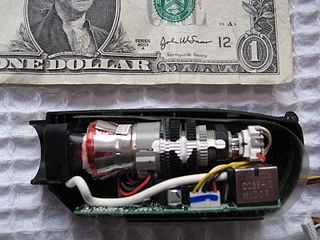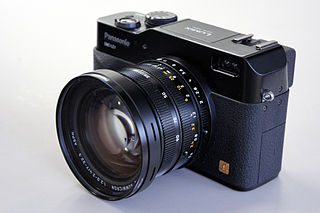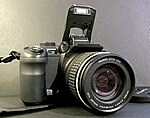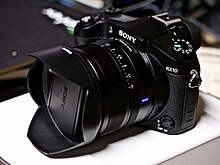
A single-lens reflex camera (SLR) is a camera that typically uses a mirror and prism system that permits the photographer to view through the lens and see exactly what will be captured. With twin lens reflex and rangefinder cameras, the viewed image could be significantly different from the final image. When the shutter button is pressed on most SLRs, the mirror flips out of the light path, allowing light to pass through to the light receptor and the image to be captured.

A digital camera, also called a digicam, is a camera that captures photographs in digital memory. Most cameras produced today are digital, largely replacing those that capture images on photographic film. Digital cameras are now widely incorporated into mobile devices like smartphones with the same or more capabilities and features of dedicated cameras. High-end, high-definition dedicated cameras are still commonly used by professionals and those who desire to take higher-quality photographs.

An electronic viewfinder (EVF) is a camera viewfinder where the image captured by the lens is displayed on a small screen which the photographer can look through when composing their shot. It differs from a live preview screen in being smaller and shaded from ambient light, and may also use less power. The sensor records the view through the lens, the view is processed, and finally projected on a miniature display which is viewable through the eyepiece.

A point-and-shoot camera, also known as a compact camera and sometimes abbreviated to P&S, is a still camera designed primarily for simple operation. Most use focus free lenses or autofocus for focusing, automatic systems for setting the exposure options, and have flash units built in. They are popular for vernacular photography by people who do not consider themselves photographers but want easy-to-use cameras for snapshots of vacations, parties, reunions and other events.

A digital single-lens reflex camera is a digital camera that combines the optics and mechanisms of a single-lens reflex camera with a solid-state image sensor and digitally records the images from the sensor.

Sigma Corporation is a Japanese company, manufacturing cameras, lenses, flashes and other photographic accessories. All Sigma products are produced in the company's own Aizu factory in Bandai, Fukushima, Japan. Although Sigma produces several camera models, the company is best known for producing high-quality lenses and other accessories that are compatible with the cameras produced by other companies.

The Canon PowerShot G is a series of digital cameras introduced by Canon in its PowerShot line in 2000. The G series cameras are Canon's flagship compact models aimed at photography enthusiasts desiring more flexibility than a typical point-and-shoot without the bulk of a digital single-lens reflex camera.

Cyber-shot is Sony's line of point-and-shoot digital cameras introduced in 1996. Cyber-shot model names use a DSC prefix, which is an initialism for "Digital Still Camera". Many Cyber-shot models feature Carl Zeiss trademarked lenses, while others use Sony, or Sony G lenses.

The Sony Cyber-shot DSC-R1 is a bridge digital camera announced by Sony in 2005. It featured a 10.3 megapixel APS-C CMOS sensor, a size typically used in DSLRs and rarely used in bridge cameras. This was the first time such a large sensor was incorporated into a bridge camera. Besides the APS-C sensor, the DSC-R1 also featured a 14.3–71.5 mm Carl Zeiss Vario-Sonnar T* lens, providing for an angle of view equivalent to 24–120 mm on a full frame camera.

Lumix is Panasonic's brand of digital cameras, ranging from pocket point-and-shoot models to digital SLRs.

Live preview is a feature that allows a digital camera's display screen to be used as a viewfinder. This provides a means of previewing framing and other exposure before taking the photograph. In most such cameras, the preview is generated by means of continuously and directly projecting the image formed by the lens onto the main image sensor. This in turn feeds the electronic screen with the live preview image. The electronic screen can be either a liquid crystal display (LCD) or an electronic viewfinder (EVF).

This article details lensesfor single-lens reflex and digital single-lens reflex cameras. The emphasis is on modern lenses for 35 mm film SLRs and for "full-frame" DSLRs with sensor sizes less than or equal to 35 mm.

The Micro Four Thirds system is a standard released by Olympus and Panasonic in 2008, for the design and development of mirrorless interchangeable lens digital cameras, camcorders and lenses. Camera bodies are available from Blackmagic, DJI, JVC, Kodak, Olympus, Panasonic, Sharp, and Xiaomi. MFT lenses are produced by Cosina Voigtländer, Kowa, Kodak, Mitakon, Olympus, Panasonic, Samyang, Sharp, Sigma, SLR Magic, Tamron, Tokina, TTArtisan, Veydra, Xiaomi, Laowa, Yongnuo, Zonlai, Lensbaby, Venus Optics and 7artisans amongst others.

The Panasonic Lumix DMC-GH1 is a digital mirrorless interchangeable lens camera adhering to the Olympus and Panasonic developed Micro Four Thirds System (MFT) system design standard. Panasonic classified the GH1 as a hybrid stills/video camera and the GH1 was introduced and marketed as a higher end camera than Panasonic's first MFT camera, the stills only, non-video capable Lumix DMC-G1.

A mirrorless camera is a digital camera which, in contrast to DSLRs, does not use a mirror in order to ensure that the image presented to the photographer through the viewfinder is identical to that taken by the camera. They have come to replace DSLRs, which have historically dominated interchangeable lens cameras. Other terms include electronic viewfinder interchangeable lens (EVIL) cameras and compact system cameras (CSCs).
The Sony Cyber-shot DSC-RX100 series is a high-end compact camera part of the wider Sony RX series. It started with the DSC-RX100, announced on 6 June 2012, and is part of the Cyber-shot RX line of digital cameras made by Sony. Seven annual generations have been released so far until 2019, all equipped with a one-inch 20-Megapixel image sensor and rotary knob around the lens. Filming at up to 1080p at 60fps is supported by the first three generations, the third additionally with 720p at 120fps, and up to 2160p (4K) at 30fps and 1080p at 120fps high frame rate video since the fourth.

The Sony RX is the name of a range of fixed lens compact point-and-shoot digital cameras created by Sony in 2012. All cameras are equipped with Carl Zeiss lenses.
























